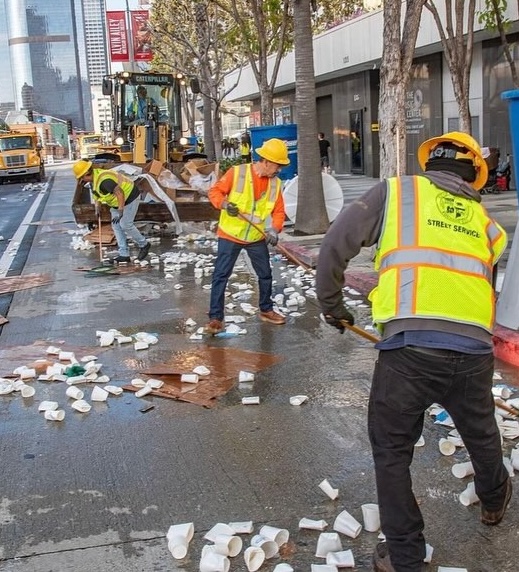South L.A.’s garbage mountains are a public health outrage: The Hutchinson Report

At three separate spots in South Los Angeles, I gaped in awe, even shock, at what I saw.
The spectacle was the endless sea of litter that stretched for more than a mile in all directions. It wasn’t just the usual garden variety trash. There were assorted furniture items, burned out cars, loads of paper, cans, bottles, debris, children’s toys and even entire kitchen items.
There were three huge problems with these urban eyesores. The first was their enormity and the wide area that they were strewn over.
The second problem was that the garbage mountains weren’t dump sites for the homeless. With one exception, there were no homeless encampments anywhere near the trash heaps.
The third problem was the gravest. These trash dumps were not just a product of clandestine, illegal, overnight dumping. They had accumulated over weeks.
The glaring question was why? Countless residents, business owners in the area as well as motorists and pedestrians could see them daily. Those same homeowners, renters and businesspersons had to live with the enormous toxic, health, safety and environmental hazard that the garbage pileups posed.
Certainly, city officials could see these dump sites too. Worse still, even if they didn’t, residents complained that they had repeatedly reported them. That is not conjecture.
A Facebook Livestream I posted on one particularly gruesome dumping site drew many angry comments from respondents who lived near the sites. They were enraged that their complaints to the city’s sanitation department as well as their city council person were ignored.
Several said that they got no response from their calls and letters of complaint. I reached out twice to the L.A. Department of Sanitation. I sent the department footage I shot of the sites.
I also forwarded some of the responses I received on my Facebook post from residents imploring the department to act on their clean-up requests. I am still waiting for a response from department officials.
This is hardly the first time that the issue of garbage dumping in South L.A. and the gaping disparity in pick up and clean up of the garbage between South L.A. and affluent parts of L.A. A decade ago, the issue sparked rage and even a demand by the L. A. City Council for action.
The immediate demand was that the Sanitation Department explain whether sanitation department officials ignored the resident’s complaints of illegal garbage dumping and the disparity in trash pickups.
The council ordered the department to develop “a plan and a timeline for the bureau to eliminate and prevent any backlog of unresolved service requests and any disparities in service.” This was an easy call to make.
Department officials pushed back and insisted that the complaints weren’t ignored and that they had devoted extra resources to garbage pickup and clean up in South L.A. and other lower income areas of the city. Again, that was a decade ago. However, the block after block of garbage items openly piled up I saw belied the claim.
The countless studies and surveys on chronic environmental racism that threaten poor Black communities in L.A. and nationally have repeatedly documented the monumental health hazards that they pose to the residents. The hazards include pollution spewing plants, toxic landfills, contaminated drinking water, and — most prominently and visibly — illegal garbage dumping sites. A report by Ecolab detailed five specific dangers that the toxic waste sites pose. They include:
• Bacteria, insects, and vermin thrive from garbage. They vastly heighten the risk of contracting salmonella, which cause typhoid fever, food poisoning, enteric fever, gastroenteritis, and other major illnesses.
• Overflowing waste causes air pollution and respiratory diseases. This causes various respiratory diseases and other adverse health effects as contaminants are absorbed from lungs into other parts of the body.
• Garbage contaminates surface waters, which affects all ecosystems. This affects everything existing in the water, including fish and other animals that drink polluted water. Hazardous household waste items such as batteries, computer equipment and leftover paints can be particularly dangerous for surface waters.
• Direct handling of overflowing waste further heightens health risks. This is especially dangerous. Many individuals who live near the garbage dump sites sort through the items. That entails actually handling them. This poses the added risk of infections, chronic diseases and accidents as well as skin and blood infections through infected wounds, various illnesses resulting from the bites of animals feeding on the waste, and intestinal infections transmitted by flies feeding on the waste.
• Inefficient waste control is bad for municipal wellbeing. This is obvious. The fact that mountainous garbage piles even exist in densely packed neighborhoods guarantees that health, safety and environmental toxins and exposure affect large numbers of individuals. That includes many children.
Residents in the affected neighborhoods are angered and demand immediate action from sanitation department officials and city officials. They must have it. There are simply too many colossal health, safety and environmental hazards that L.A.’s mountainous garbage piles pose that threaten too many lives.
Earl Ofari Hutchinson is an author and political analyst. His forthcoming book is “Trump for Sale“ (Middle Passage Press). His weekly Hutchinson Report is streamed on Facebook Livestream.





